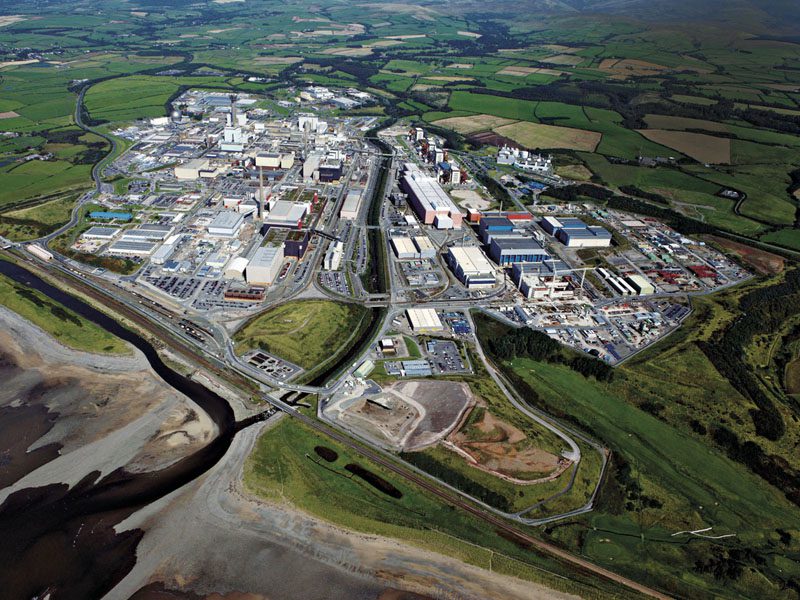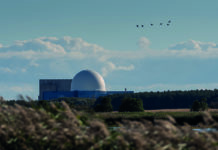
Geological disposal is the only proven, technically feasible option for dealing with high level radioactive waste. But its deployment has never gotten off the ground in the UK (or under it, it might be more apt to say), for various reasons. Envirotec reports on a recent presentation on the topic by Professor Rebecca Lunn of the University of Strathclyde, the leader of a multi-disciplinary research consortia on radioactive waste disposal.
In the timeline of the history of the UK’s attempts to do something about storing its nuclear waste safely, the late 1980s seems a key moment. At that point, there appeared to be momentum building behind the idea of disposing of fuel underground near the Sellafield site. The decision went to an enquiry in 1995, failed to get planning permission, and “there was a stall in the whole process”, said Lunn. This was for a variety of reasons, none related to engineering safety.
Things picked up again in 2003, probably nudged by the Government’s realisation that extra nuclear power capacity would soon be needed to keep the lights on, adding urgency to the quest for a safe disposal route for waste. The Government set up the Committee on Radioactive Waste Management (CoRWM), a group of non-experts who met regularly over a two-year period, exploring the full range of options for disposal, including things like shooting it off into space or placing it in underground subduction zones.
CoRWM’s members made a full-time commitment to the group, educating themselves on the various options. It eventually recommended geological disposal – in other words, burying waste underground in a specially engineered facility. Cited by Lunn as “the UK’s only real example of deliberative decision making in policy” the decision appears to have incorporated a wide range of criteria and opinion, including extensive public consultation, and a testimony to its robustness would seem to be that it still stands as a policy, completely unopposed. CoRWM also recommended safe interim management of wastes while such a facility was built.
CoRWM produced a white paper A Framework for Implementing Geological Disposal, in 2008, but its recommendations have so far failed to reach the implementation phase (on which point, more later). But first: What exactly is radioactive waste and where does it come from?
Types of waste
Lunn’s presentation divided radioactive waste into three categories: low, intermediate and high level. In the low level category you have rubble, soil and steel, some of which can be cleaned and disposed of normally. Intermediate level mostly comprises nuclear fuel casing, as well as sludges arising from the treatment of radioactive liquids, and graphite from reactor cores. High level waste is the hot, active waste derived from nuclear fuel reprocessing – what defines it in this category is the fact that it is heat generating, said Lunn, so it requires different options for disposal.
Where is it?
Most of this waste is stored at existing nuclear facilities, and in the UK most of it is stored at Sellafield. The bulk of it is spent fuel reprocessing and nuclear power reactors, although there are smaller contributions from energy research, the medical industry (from equipment used in imaging and radiotherapy), defence and wastes from the production of fuels for nuclear power.
How much is there?
Compared to conventional hazardous waste, the UK’s radioactive waste actually constitutes quite a small volume of material. In volume terms it is about 4.5 million cubic metres (about four times the volume of Wembley stadium), less than a million cubic metres of which is low or intermediate level waste. But this is just the legacy waste, and doesn’t include what will be coming down the pipe from new-build nuclear power stations.
Who is doing it?
So geological disposal (GD) is at present the only proven technical option for its disposal. There are 13 countries attempting to deploy it, for a variety of waste types. This includes four operational sites and three which are under construction. In the proximity of the UK, Finland has one that is well into the construction phase. Another project, in Sweden, has recommended a site, its licensing is being reviewed and it is supposedly close to a decision over construction. In Switzerland, France and a number of other countries, a number of projects are seemingly close to siting a facility.
The technology and geology
Geological disposal involves the construction of a nuclear waste repository, an engineered facility located deep below the ground – UK policy is 200m to 1000m below the surface (although 500m is seemingly a more likely minimum depth). The safe and enduring consignment of this material underground relies to some extent on the surrounding geology, “but it also has a great deal of engineering within it,” said Lunn, with a carefully designed series of barriers encapsulating the different layers in which it is encased.
Packaging the waste
To make nuclear waste suitable for disposal you have to construct “a waste form” – a solid stable form whose chemistry will be unchanging – which is then placed within a “package”, which in turn is surrounded by heavily engineered seals. “The geology is there to ensure your engineered barriers remain where they’re supposed to be,” said Lunn, so it should provide a stable environment, with minimal seismic activity, for example. Overall, it should be possible to isolate the waste for a long time, without the need to perform any maintenance.
GD concepts so far explored fall into three basic categories, depending on the type of rock present in the region where the waste is to be deposited: hard rock, salt or clay.
First category: Hard rock repositories
In the first category are the Swedish and Finnish sites, which are to be situated in granodiorite, a very microfine granite. Lunn provided an outline of the design of a facility along these lines, with spent fuel surrounded by successive layers including a cladding tube, a ductile iron insert and then a thick copper canister. The canister sits within a casing of bentonite – this is a type of clay that swells when it becomes wet, producing a very tight seal (the pressures can reach 10MPa at the interfaces between the rock, bentonite and canister). This is also useful as bacteria can’t withstand these pressures, eliminating the possibility of microbially-enhanced corrosion.
The slight plasticity acquired by moist clay also provides protection against earthquakes.
Second category: salt rock repositories
In the salt rock-based category of disposal site are the US (New Mexico)-based Waste Isolation Pilot Plant (WIPP), which began receiving waste in 1999, and Germany’s Morsleben radioactive waste repository, which stopped receiving waste in 1998.
As Lunn mentioned, there was an accident in the WIPP in 2015, but this was seemingly not down to the design of the repository but the fact that “somebody thought it would be a good idea to use cat litter as part of the waste form”, because it would be cheaper than the purified waste form, and this left organics sealed within the facility which produced gases. This was a problem of operational management, and not keeping an eye on what people were doing with the packaging of waste.
Salt should function as a repository, in that it tends to incorporate any water into its crystalline structure, avoiding materials migration – in other words, anything that leaks from a waste canister won’t be going anywhere (like the surface). However, Lunn said it is difficult to engineer a waste repository in salt, and there is a danger that any tunnels in the material will start to close up.
Internment of nuclear waste at the Morsleben facility was suspended in 1998 after it became clear that the surrounding salt structures had deteriorated and were in danger of collapse. Currently the site is the focus of closure and remediation work.
Third category: Clay repositories
Clay repositories, said Lunn, “work in a fundamentally different way” from these other GD concepts in that they depend upon the properties of the rock to a much greater degree. Examples includes sites operated by the French national radioactive waste management agency (ANDRA).
The safety case
A prerequisite for siting a GD facility is the production of a safety case, which is defined as “a formal compilation of evidence, analyses and arguments that quantify and substantiate a claim that the repository will be safe”, according to a definition from one of the nuclear regulatory authorities. For a project like the Swedish one, this might comprise rooms full of material (if printed out) – several gigabytes of documents. In the UK it might take one or two decades to collect the required information – it is a major undertaking in terms of both site investigation and designing the engineering aspects of the facility, said Lunn. The safety case has to gain the approval of various regulatory bodies, principally the Environment Agency (EA), for whom it has to demonstrate safety over the (very) long term – 10k to a million years. And a constructional and operational case has to gain the approval of the Office for Nuclear Regulation (ONR).
Siting challenges
A siting process took place in the UK, between 2009 and 2013, after the 2008 CoRWM white paper was launched. All UK local authorities were asked if they wanted to express an interest, with there being a plan to conduct a consultation period, following which they could make a decision over participation. The white paper outlined a community benefits package which would be part of any deal struck.
Only councils in Cumbria, Allerdale and Copeland expressed an interest – all within the vicinity of Sellafield. Moray polls conducted in all three localities showed net public support. In Cumbria, however, the council voted against it. Vocal NGO and local campaigns appear to have been a major factor. The latter made a number of claims against the proposal, many of which appeared to be unsound, explained Lunn, which – while not appearing to influence the public – may have applied pressure to councillors tasked with the final decision.
Lunn looked at a sample page from one of the anti-GD campaigners involved, David Smythe, to examine the objections. It presented a cross section of the nearby Lake District coast in the vicinity of the proposed GD site.
One problem envisioned was that of rain water making its way 500m below ground to the GD facility then returning to circulate on a beach indicated on the diagram. Such a long downward journey for rainwater clearly fails to take account of natural features like the Lake District boundary fault. The reason GD sites have a minimum depth is not to accommodate travel times for radionuclides but to ensure the facility is not within an area where fresh water will be circulating. At the proposed siting depths the water also becomes saline (the saline interface in the UK is between 100m and 300m depth), and there is virtually no mixing between saline and fresh waters (hence the fact that saline waters in this region have in some cases been dated to millions of years old).
Lunn reviewed the lessons we could likely learn from a few decades of not getting anywhere with the problem. Journalists aren’t experts, and long-winded scientific and technical explanations tend to be sidelined in the quest for a good story. This all serves to make it difficult for the public, and decision makers like local councillors, to weigh one argument against another, especially if the arguments are complicated, she said, citing the MMR vaccine controversy in the 1990s as a case in point.
Government policy
A supportive government policy is also a prerequisite. Lunn’s talk focused mostly on UK Government policy, but in answer to a direct question on the matter she bemoaned a current gap in Scottish policy documentation. She said: “There is a shallow disposable policy for short-lived wastes and there is a low level waste policy but for longer-lived, higher level waste, there is no government policy – it’s ‘store at the surface for ever and ever’”.
She concluded with the view that public consultation and transparency is essential to enlisting political support for siting – as appears to have been the lesson of the recent Swedish and Finnish siting projects. But this is certainly challenging, for the above reasons. Our present world of social media, ‘false news’ and the like makes it even easier to “create a big storm”.
Problems with public understanding appear to have dogged siting attempts in the UK and US, which have not failed on safety or engineering but on local acceptability and the political process.






